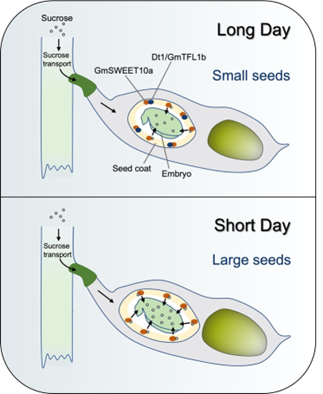News
Researchers' " photoperiod " Discovery regulate soybean seed weight
Date: Apr 02, 2024
Guangzhou researchers have teamed up with china scientists to successfully identify the Dt1 as a new negative regulator to control soybean seed weight that provide new insights into how soybean seed development responds to photoperiod at different latitudes.
Soybean is a photoperiod-sensitive short-day crop whose reproductive period and yield are markedly affected by day-length changes. Seed weight is one of the key traits determining the soybean yield; however, the prominent genes that control the final seed weight of soybean and the mechanisms underlying the photoperiod’s effect on this trait remain poorly understood.
"With the discovery, we unveiled a new mechanism of how seed weight is controlled by photoperiod in crops, offering an ideal genetic component for improving soybean’s yield by manipulating its seed weight and growth habit," said HOU Xingliang, a chief researcher from the South China Botanical Garden under the Chinese Academy of Sciences.
Dt1, an orthologous gene of Arabidopsis TFL1 that is known to govern the soybean growth habit, Li and colleagues have utilized a combination of genetic, molecular, and biochemical approaches to unveil the novel regulatory mechanism underlying seed weight in soybean. They have performed laborious work to identify the Dt1 as a new negative regulator to control soybean seed weight. Strikingly, Dt1 interacts with the sucrose transporter GmSWEET10a on the plasma membrane to regulate the efficient sucrose transport in a photoperiod-dependent manner to modulate the early stage of seed development.
This study has unveiled a new mechanism of how seed weight is controlled by photoperiod in crops, which also lays the groundwork for precise molecular breeding in soybean.

File Download: